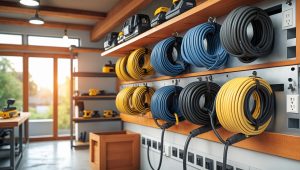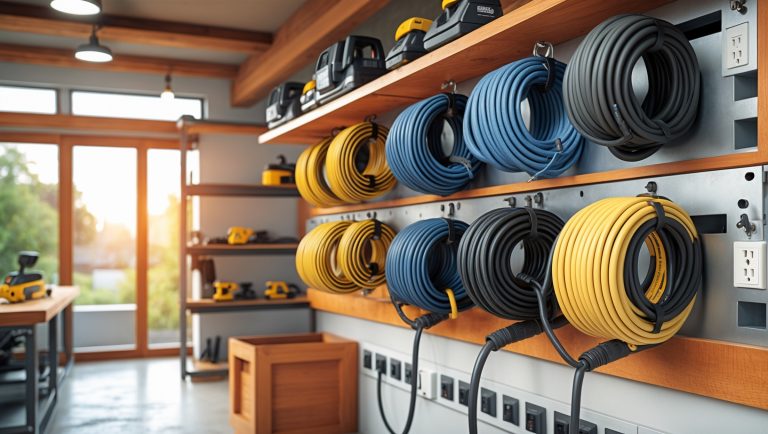Introduction: Why Upgrade to a Smart Garage Door Opener?
The garage is more than a place to park your car—it’s a gateway to your home, a workshop, and often a storage hub for your most valuable tools and equipment. Yet, many homeowners overlook the garage door opener, sticking with outdated models that lack modern security and convenience features. Enter the smart garage door opener: a transformative gadget that empowers you to control access remotely, monitor real-time status, integrate with smart home systems, and enhance your overall home security.
If you’re a DIY enthusiast who enjoys simplifying home upgrades and repairs, installing a smart garage door opener is an excellent project. This guide will take you through each step of the installation process, from choosing the right model to wiring, mounting, app integration, and troubleshooting. Whether you’re seeking better package security, improved convenience, or just love tinkering with the latest gadgets, this detailed walkthrough will equip you with practical know-how and confidence to get the job done—without the need to call a professional.
Let’s roll up our sleeves and transform your garage with a smart opener that adds value, security, and a touch of high-tech convenience to your home.
Choosing the Right Smart Garage Door Opener
Compatibility and Requirements
Not all smart garage door openers are created equal. Before making a purchase, consider the following:
- Existing Door Type: Is your current garage door sectional, tilt-up, or roll-up? Most smart openers are designed for sectional doors, but adapters exist for others.
- Opener Compatibility: Are you replacing the entire opener or adding a smart controller to an existing system? Some devices retrofit onto older openers, while others require full replacement.
- Wi-Fi Strength: Your garage needs a reliable 2.4GHz Wi-Fi signal. Test connectivity before installation; consider a Wi-Fi extender if needed.
Top Features to Look For
- Remote App Control: Allows open/close operations and notifications via a smartphone app.
- Integration: Works with Alexa, Google Assistant, Apple HomeKit, IFTTT, etc.
- Activity Logs: Tracks door usage for added security.
- Guest Access: Lets you temporarily share access with family or delivery services.
- Battery Backup: Keeps the system functional during power outages.
- Auto-Close and Safety Sensors: Prevents accidental closures and enhances safety.
Popular Models Compared
- Chamberlain MyQ: Great retrofit option for existing openers; broad app support; no monthly fees for basic features.
- Genie Aladdin Connect: Compatible with most openers; supports voice control and monitoring.
- Tailwind iQ3: Advanced automation and geofencing; excellent for tech enthusiasts.
- Meross Smart Garage Door Opener: Budget-friendly; easy installation; Apple HomeKit support.
Tools and Supplies Checklist
- Philips and flathead screwdrivers
- Adjustable wrench and socket set
- Power drill with drill bits
- Step ladder (6-8 feet recommended)
- Wire stripper and electrical tape (if wiring is required)
- Stud finder (for mounting brackets)
- Measuring tape and pencil
- Level
- Safety goggles and gloves
- Smartphone (for setup and testing)
- Wi-Fi extender (optional, if connectivity is weak)
Preparation: Safety and Pre-Installation Steps
Safety First
- Unplug the existing garage door opener before starting any work.
- Ensure the garage door is fully closed and locked in place.
- Wear safety goggles and gloves to protect against debris and sharp edges.
- Keep children and pets away from the workspace.
Assessing Your Garage and Opener
Take a few minutes to:
- Inspect the garage door for smooth operation and balance. Lubricate hinges and rollers if needed.
- Check existing wiring and power outlets. Plan a cable route if installing a new unit.
- Locate a suitable place for the opener’s hub or controller—ideally near your existing opener and within Wi-Fi range.
Step-by-Step Installation Guide
1. Remove Old Opener (If Replacing Entire Unit)
- Unplug and disconnect all wiring from the old opener.
- Support the opener with a ladder and unbolt from the mounting brackets.
- Carefully lower and remove the old unit.
- Retain mounting hardware if compatible with the new opener.
2. Assemble the New Smart Opener
- Follow manufacturer instructions to assemble the rail, carriage, and motor unit.
- Lay out all parts and hardware before beginning assembly.
- Attach mounting brackets to the ceiling joist using a stud finder for secure placement.
3. Mount the Opener
- Lift the motor unit onto the ladder or a helper’s support.
- Align the rail with the center of the garage door.
- Secure the opener to the mounting brackets and check that the rail is level.
- Attach the rail to the door header bracket above the garage door.
4. Connect Door Arm and Safety Sensors
- Attach the door arm to the carriage and to the door bracket.
- Mount safety sensors 6 inches above the floor on each side of the door track.
- Run wiring along the wall and ceiling, securing with cable clips or staples.
- Plug in and test sensor alignment—most units indicate correct alignment with a solid LED.
5. Wire the Wall Control and Accessories
- Install the wall-mounted control panel near the garage entry door.
- Connect wiring to the opener as per the instruction manual.
- Mount any additional keypads or remotes, following manufacturer guidelines.
6. Power Up and Initial Test
- Plug in the opener and restore power.
- Test the open/close function with the wall control and remote.
- Observe for smooth operation—listen for unusual noises, and ensure the door reverses when blocked.
7. Smart Features Setup and Wi-Fi Connection
- Download the manufacturer’s app on your smartphone.
- Follow in-app prompts to connect the opener to your home Wi-Fi network.
- Name your garage door for easy identification (helpful for multi-garage homes).
- Test app control to open and close the door remotely.
8. Integrate with Other Smart Home Devices
- Connect the opener to voice assistants (Alexa, Google Assistant, Apple HomeKit) if supported.
- Set up routines or automations—e.g., auto-close at night or open when you arrive home.
- Enable notifications for door status, activity, or failed closures.
Troubleshooting Common Issues
Wi-Fi Connection Problems
- Ensure your garage is within Wi-Fi range; use a Wi-Fi extender if needed.
- Connect to a 2.4GHz network, as many openers don’t support 5GHz bands.
- Reboot your router and the opener if initial pairing fails.
Sensor Alignment Errors
- Double-check sensor alignment; adjust until both LEDs are solid.
- Clear any obstructions or cobwebs from sensor lenses.
- Replace sensor wires if damaged or frayed.
Mechanical Issues
- If the door sticks or jerks, lubricate all moving parts and check for track obstructions.
- Ensure the opener rail is level and all mounting bolts are tight.
- Adjust force and travel limits per the instruction manual if the door won’t fully open or close.
Maintenance Best Practices for Longevity
- Test the safety reversal system monthly by placing an object in the door’s path.
- Check and tighten all bolts, brackets, and hardware every 6 months.
- Lubricate door hinges, rollers, and opener rail twice a year.
- Inspect safety sensors and clean lenses regularly.
- Update opener firmware through the app when notified.
- Back up access codes and app credentials in a secure location.
Safety and Security Tips
- Use strong, unique passwords for app and device login.
- Enable two-factor authentication if available.
- Set auto-close timers for added security if you forget to close the door.
- Limit shared access to trusted users and revoke guest permissions promptly.
- Keep the emergency release cord accessible but out of easy reach from outside.
- Regularly review opener access logs for any unusual activity.
Cost Breakdown and Budgeting
- Smart Garage Door Opener: $120–$350, depending on features and brand.
- Installation Accessories: $10–$30 for wiring, brackets, fasteners, and adhesives.
- Wi-Fi Extender (if needed): $25–$50.
- Optional Tools: Most homeowners will already have basic tools; otherwise, budget $40–$80.
- Total DIY Installation Estimate: $130–$430, much less than the $500–$700 charged by professional installers.
Don’t forget to check for rebates or smart home upgrade incentives from your utility provider or local municipality.
Conclusion: Enjoying the Benefits of a Smarter Garage
Installing a smart garage door opener is a rewarding DIY project with immediate and long-term benefits. You gain peace of mind knowing you can check and control your garage door from anywhere, enhance your home’s security, and even streamline package deliveries or guest access. The convenience of integrating with your existing smart home ecosystem, setting automated routines, and receiving real-time notifications transforms the humble garage into a tech-savvy entry point—all without monthly fees or complex wiring.
Beyond the high-tech perks, this upgrade also means fewer lockouts, less worry about forgetting to close the door, and a safer environment for your family. With the detailed step-by-step instructions above, you’ll save money compared to hiring a pro, learn valuable installation skills, and have the satisfaction of a job well done.
Remember to maintain your new opener with regular tests and firmware updates, keep security settings tight, and continue exploring new integrations as smart home technology evolves. By taking this project into your own hands, you’re not just enhancing your garage—you’re investing in a smarter, safer, and more convenient home for years to come. Happy upgrading!











The article mentions that most smart garage door openers are designed for sectional doors, but adapters exist for other types. Could you elaborate on which brands or models are best for tilt-up or roll-up garage doors and any unique installation steps to be aware of?
For tilt-up and roll-up garage doors, brands like Chamberlain and Genie offer models that are compatible with adapter kits. The Garadget and Nexx Garage controllers also work well with these door types when paired with the correct adapters. During installation, you’ll often need to mount sensors differently—typically to the door frame rather than the panels. Always check the manufacturer’s compatibility list and follow their specific instructions for alternative door types to ensure safe operation.
In the section about opener compatibility, you mention adapters for tilt-up and roll-up doors. Are there any well-known brands or models you recommend for those specific door types, or is there anything important to watch out for during installation?
For tilt-up and roll-up garage doors, Chamberlain and Genie offer adapter kits that work with most smart openers. When choosing an adapter, be sure it matches your door type and opener model. During installation, pay special attention to how the adapter mounts—tilt-up doors often need extra clearance, and roll-up doors may require reinforced brackets. Always follow the manufacturer’s instructions for safety.
You mentioned the importance of Wi-Fi strength in the garage. What are some reliable ways to test the signal before installing the opener, and do you have a recommendation for cost-effective Wi-Fi extenders if my signal is weak?
To check your garage’s Wi-Fi strength, try standing in the garage with your smartphone and see how many Wi-Fi bars you get or use a free Wi-Fi analyzer app for more detailed signal info. If the signal is weak, consider plug-in Wi-Fi extenders from brands like TP-Link or Netgear. They’re easy to set up and usually offer good performance at a reasonable price.
I noticed you mentioned checking Wi-Fi strength in the garage before installing a smart opener. If my garage only gets a weak signal, do you recommend a specific Wi-Fi extender or type of setup that works best for smart door controls?
A mesh Wi-Fi system or a dual-band Wi-Fi extender located midway between your router and garage usually works best for smart garage door openers. Look for extenders that support both 2.4GHz and 5GHz bands, since many smart devices use 2.4GHz. Popular brands like TP-Link, Netgear, and Google Nest Wi-Fi are reliable options. Place the extender where it still receives a strong signal from your main router for the best results.
About the installation process—how long should a typical DIYer expect to spend on this project from unboxing to app integration? I have a busy weekend and want to know if this can reasonably be done in just one afternoon.
Most DIYers can complete the installation of a smart garage door opener in about 2 to 4 hours. This includes unboxing, mounting the hardware, wiring, and going through the app setup and integration. Assuming you have basic tools and follow the step-by-step instructions, it’s definitely reasonable to finish this project in a single afternoon.
I noticed adapters are available for tilt-up and roll-up doors, but are there any major installation challenges or extra steps to expect if I’m not working with a standard sectional garage door?
Yes, installing a smart garage door opener on tilt-up or roll-up doors can present a few extra steps. For tilt-up doors, you may need a special bracket to securely attach the opener, and aligning the lifting arm can be trickier. Roll-up doors often require specific adapters and may need extra clearance for the opener’s mechanism. Always check your opener’s compatibility and follow any manufacturer instructions for your door type to avoid installation issues.
The article talks about deciding between a full replacement opener and just adding a smart controller. For a small business owner on a tight budget, is there a noticeable difference in performance or features between the add-on controllers versus getting a whole new smart opener?
Add-on smart controllers are usually much more affordable and allow you to keep your existing opener. They offer basic smart features like remote control, scheduling, and status alerts. However, a full smart opener may run more quietly, have better security, and include advanced features like battery backup or integration with more platforms. If you’re mainly after smartphone control and cost savings, an add-on controller should cover your needs.
When deciding between retrofitting a smart controller to an old opener versus replacing the entire system, what should I consider in terms of security and long-term reliability? Are there situations where retrofitting just isn’t worth it?
When choosing between retrofitting a smart controller and replacing your opener, think about your current system’s age, compatibility, and safety features. Retrofitting is often cost-effective, but older openers may lack modern security protocols or rolling code technology, making them more vulnerable. If your opener is over 15 years old, unreliable, or missing essential safety features, replacing it is usually safer and more reliable in the long run.
How long does the whole installation process usually take for someone who’s fairly handy but hasn’t done much wiring before? I’m wondering if this is something I could get done in an afternoon or if I should set aside a whole weekend.
If you’re fairly handy but new to wiring, you can usually complete the installation in about 2 to 4 hours. Most DIYers find it manageable in one afternoon, including setup and testing, as long as you follow the instructions closely and have the basic tools ready. You likely won’t need the whole weekend unless unexpected issues come up.
When it comes to integrating the new smart opener with an existing setup versus doing a full replacement, are there specific brands or models that make retrofitting easier for older garage door systems without much rewiring?
Yes, several smart garage door openers are designed specifically for easy retrofitting with older systems. Brands like Chamberlain (with the myQ Smart Garage Hub) and Nexx Garage offer models that work with most existing openers by connecting wirelessly or with minimal wiring. These tend to avoid the need for a full replacement and usually require just mounting the device and connecting two wires to your opener’s terminals. Always check compatibility with your current opener model before purchasing.